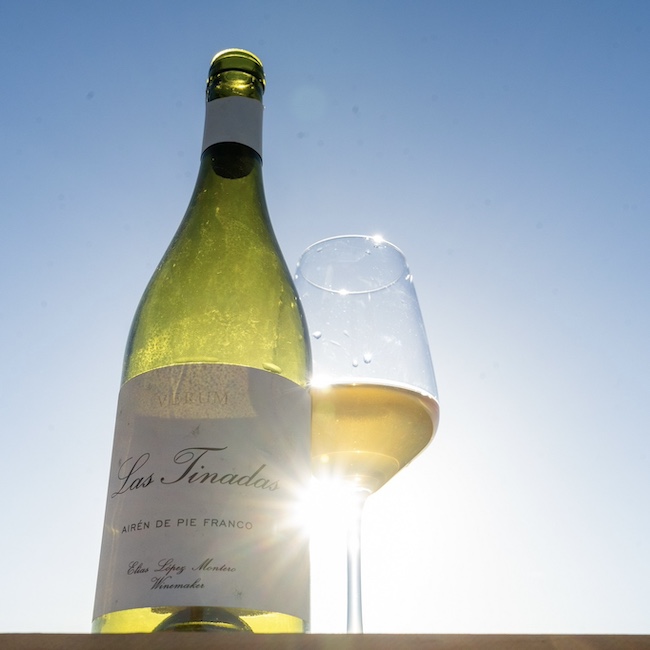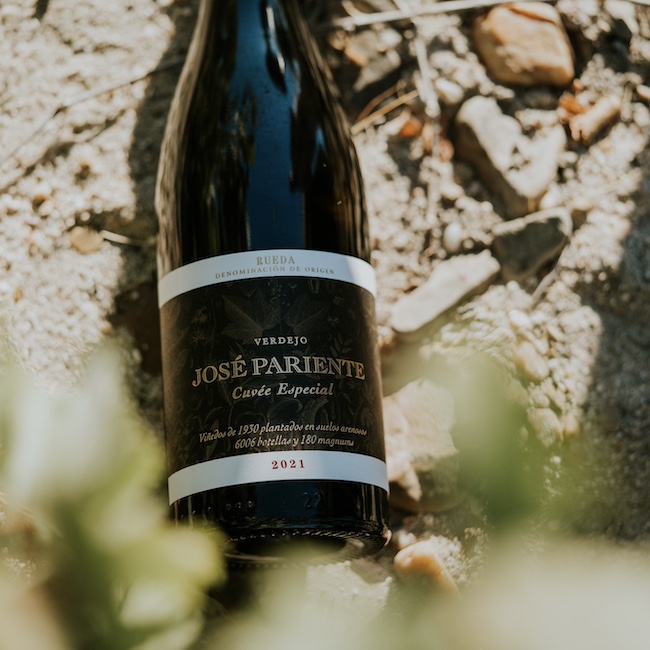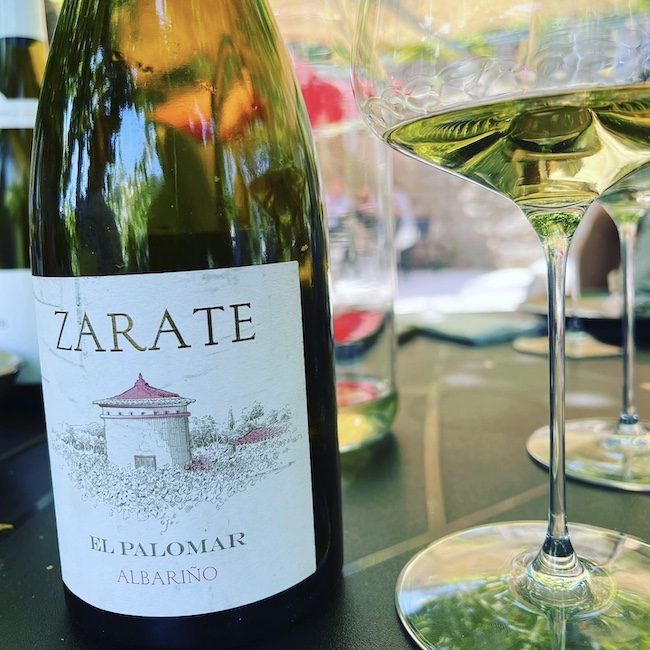by Almudena Alberca - @almudenaalbercamw
.png.transform/rendition-xs/image_image%20(1).png)
Master of Wine Almudena Alberca talks about aging on lees by great Spanish wines from north to south and east to west

by Almudena Alberca - @almudenaalbercamw
White wines are clearly trending. Consumption has been increasing for at least five years, and according to the latest report by the OIV (International Organisation of Vine and Wine), white wine surpassed red wine production once again in 2021. This trend has led to a hitherto unseen increase in value for white grapes, fetching higher prices than red ones, and an increase in the selection of wines offered in the best restaurants across Spain and around the world.
This trend is fantastic for Spain because the country's climatic and orographic diversity gives rise to an infinite number of exciting varieties and styles—something for everyone.
There are different styles of white wines, although the most common are the ones we consume fresh and fruity within the first year of production. Additionally, there are great white wines with ageing potential due to the characteristics relating to their varietal, origin, and production.
When they consider making a white wine for aging, winemakers usually use two techniques that can be used separately or together: aging on lees, with wood or without it. Both techniques are used in dry wines as well as in sparkling wines.
Wine is a fermented beverage in which yeasts from part of its transformation. Once the sugars in the must have been depleted, the yeasts die out and slowly fall to the bottom of the barrel. These yeasts are tiny living beings that contain fatty acids and proteins among other compounds that will gradually give way to the wine. The organoleptic effects on the wine are primarily aromatic, with creamy notes reminiscent of baked goods and promote the notes that are typical of the grape variety. The wine's fluidity increases and becomes denser. The tactile sensations become silkier, lengthening the persistence of the flavor in the mouth.

Allies of less aromatic varieties
In general, lees are usually used in varieties with neutral or low aromatic potential, as is the case of Viura, the improved version of international Chardonnay. In any event, there are always exceptions, as we'll see later on.
These less aromatic varieties offer a perfect foundation on which to build greater complexity, both aromatic and gustatory, through the aging of the wine on its lees.
The most widely planted white variety in the world and, therefore, in Spain, is Airén, which is relatively neutral, with subtle and delicate aromas. Two great examples of these wines are El Cerrico, from Bodegas Cerrón in Jumilla (Murcia), and Las Tinadas, from Bodegas Verum (Tomelloso, Castile-La Mancha). Both producers share many characteristics, such as the selection of very old vineyards in singular soils in their areas, the use of clay vessels, and above all a prolonged aging on lees to provide the wine with greater complexity and aging capacity. The Cerrón brothers age El Cerrico for 16 months in different containers, while Verum ages it for 8 months, thus obtaining two completely different wines.
A biodynamic approach, and lees
In the case of Muchada-Léclapart winery's moscatel, it's unlike the previous wine and employs a less-common strategy when it comes to lees. This wine is made from 100% Moscatel grapes from 45-year-old vineyards in Chipiona (Cádiz, Andalusia). Like the Cerrón family, they use a biodynamic approach on their vineyards, thus increasing the range of aromatic nuances of their wines. This approach includes soil management with shallow plows, animal traction, and small tractors, which allow them to maintain the layers of microorganisms in the soil. They also don't use chemical fertilizers, and the amounts of compost they use are minimal, with the result that the soil is nourished. Their unique moscatel ages for 9 months on its lees, which work actively and in large proportions to leave their mark on the wine.
In grapes from vineyards that are worked biodynamically, the biodiversity of the soil is greater, which directly improves water retention and the accumulation of micronutrients, as well as enhancing their absorption. As a result, the plant is much healthier and stronger. This improves the expression of the grapes, leading to a greater aromatic concentration.
Below are two examples of wines made by bodegas that apply biodynamic principles in their vineyards. The first is Lagravera (Costers del Segre DO, Lleida, Catalonia), which produces the wine Ónra Blanco. In this wine, we can find the subtle, perfumed expression of Garnacha Blanca, which dominates the wine in 88% of the blend, and 12% Sauvignon Blanc, an aromatic variety par excellence. The wine is aged on its lees for 5 months, enhancing its aromatic notes and persistence in the mouth: it's one of the masterpieces of winemaker Pilar Salillas.

Lees in Ribera del Duero and Rueda
The second is the Callejo family's El Lebrero, a fantastic example of a wine made primarily with the Albillo Mayor grape from Ribera del Duero. The wine spends 9 months on its lees, a dynamic contact as the lees are stirred from the harvest until the arrival of spring. It's not just the lees that make El Lebrero a great wine: it's also the selection of plots in an area rich in limestone, the use of different fermentation and aging materials, and a partial fermentation on skins make this wine a leader for this white variety in the area.
If we follow the Duero River, we reach Designation of Origin Rueda. Verdejo is difficult to work with using lees since its aromatic profile is reminiscent of fennel and basil, which can make it challenging to add or assemble the notes from the lees, which are reminiscent of baked goods; however, there are always exceptions, and José Pariente winery imprints this style on its José Pariente Cuvée Especial.

The lees in Atlantic wines and sparkling wines
In Atlantic wines and, specifically, Galician ones, lees are used to create dream wines. Fernando Algueira of Adega Algueira (Lugo, Galicia) makes a blend of Godello and Treixadura grapes from Ribeira Sacra. The wine spends 8 months in the barrel in contact with its lees. The reductive character, which defines the winery's style, slowly gives way to aromas of ripe pear and stone fruit, which go perfectly with the pastry notes provided by the lees.
In Rías Baixas, there are numerous examples, all of them delicious, made with Albariño grapes, such as those from wineries like Do Ferreiro, Albamar, and El Palomar de Zárate. The high natural acidity of Albariño gives the wines a very high aging potential. This, mixed with the work of the lees, gives rise to very fine wines to enjoy in the moment, but also for a very long and slow aging process in the bottle.
This article could not come to an end without a toast, for example, with a Gramona Enoteca Brut Nature (Cava DO), where the 2002 vintage spends a whopping 168 months resting on its lees. The Xarel.lo and Macabeo grapes do the rest. It's important to enjoy this wine slowly to discover those 12 years of bottle aging in the class. Cheers!